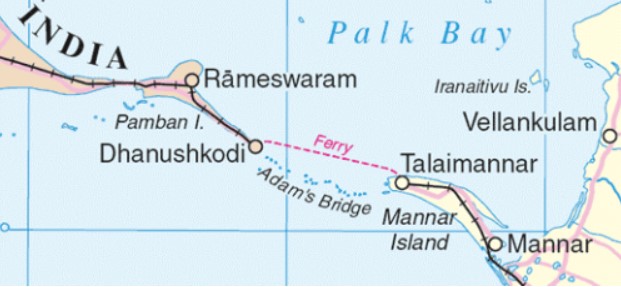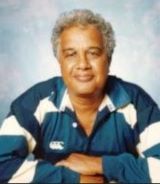The Bharathas of Sri Lanka: Roots and Tales-by Michael Roberts

Source:Thuppahis
 India and Sri Lanka are geographically very near, but yet so far in culture, civilisation and genetic diversity. As depicted in the map above, the sub-oceanic existence of the hitherto mystical “Adams Bridge” between Dhanushkodi in India and Talaimannar in Sri Lanka has now been conclusively shown to exist through aerial mapping. It is thus reasonable to conclude that natural movement would have occurred between India and Sri Lanka over the aeons. While there is much documented history about Sinhalese and Tamils, there appears to be a relative dearth of public knowledge of a smaller migrant race called the Bhāratha’s. The writer hopes this compilation will improve the knowledge of this now vanishing group who have unobtrusively and yet so selflessly contributed so much to the history of this Island nation.
India and Sri Lanka are geographically very near, but yet so far in culture, civilisation and genetic diversity. As depicted in the map above, the sub-oceanic existence of the hitherto mystical “Adams Bridge” between Dhanushkodi in India and Talaimannar in Sri Lanka has now been conclusively shown to exist through aerial mapping. It is thus reasonable to conclude that natural movement would have occurred between India and Sri Lanka over the aeons. While there is much documented history about Sinhalese and Tamils, there appears to be a relative dearth of public knowledge of a smaller migrant race called the Bhāratha’s. The writer hopes this compilation will improve the knowledge of this now vanishing group who have unobtrusively and yet so selflessly contributed so much to the history of this Island nation.
First documented in Indian literature of Sangam anthology (1) Bhāratha’s originated from Paravar’s or Parathar’s who are an ancient aristocratic seafaring warrior caste of Tamil Nadu and Kerala. Delving further into history, Edgar Thurston (2) referring to Church records (Latin Historica Eccliasastica) states that the Paravar’s and the Paravaims referred to in the Bible are the same. The Paravar’s derive their origins from the Indus Valley, a Bronze Age civilisation recorded together with Egypt and Mesopotamia dating from 3300 BCE(3). Moving to the south coast of India the Paravar’s acquired their title from the classic Tamil denotation of PARAVAN – Man of the Sea. In 712 AD, there began the Arab Muslim invasion of the Indus Valley, locally called the Sindhus valley which lies in the north of India, at the base of the Himalayan mountain ranges. This invasion which lasted till the 1300’s prompted the movement of the Paravar’s to the Coromandel Coast on the South-east of the India where they began to utilise their knowledge by combining mathematics and astronomy in plotting sea voyages. Boat building flourished and the first recorded catamaran with two hulls was made by Paravar’s (6). Gaining experience of the sea as fisherman, they widened their purview of the ocean by mapping areas where Oyster beds flourished. Bhāratha folklore has is that Pearl divers were always anchored by a rope to their brothers in law because if the diver drowned, the survivor would be beholden to care for the sister of the perished one!
Pearl diving is where the connection of the Paravar’s (now the Bhāratha’s) to our Island begins. Legend has it that in the 1400’s, Arab Horse Traders, ensconced in Puttalam, were monopolising the very valuable Pearl trade. Incensed by an encroachment on what they considered to be their domain, the Paravar’s, using their sea-faring skills, sailed across the Indian Ocean to make regular forays into this monopoly. Over time, they completely displaced the Arabs, and as a reward, the King of Sri Lanka at that time, King Parakrama Bahu VI of Kotte welcomed them as his subjects. Integrating very well with the natives, they initially settled down on the coast at Mannar where many of the descendants of the original families still remain.
Paravar Pearl Divers in Mannar–Wilkipedia Common source material
In the late 1490s & 1500s began the Portuguese occupation of India and Sri Lanka with natural proselytising of the natives to Catholiscm. A notable arrival at this time was Saint Francis Xavier who converted almost all Paravar’s from Hinduism to Christianity – the first entire Indian community to change. In October 1542 he initially baptised over 10,000 and the total swelled to over 30,000. Their Hindu link is still retained in today’s Bhāratha tradition, where the Thali or Thirumangalyam, the southern Indian symbol of marriage, tied around the bride’s neck, features the Catholic image of the Holy Ghost.
The most popular Bhāratha’s name, Fernando, comes from the Portuguese race. Others, too numerous to list completely, but still retaining the Portuguese heritage are names like Almeida, Britto, Carwallio, Coonghe, Corera, Costa, Croos, Dabrera, De Rose, De Silva, Feldano, Figurado, Fernandez, Gomez, Lobo, Mascarenhas, Mirando, Moraes, Paldano, Paiva, Peeris, Pereira, Pinghe, Prasagna, Rayan, Rayer, Rodrigo, Roche, Rubeiro, Soris, Soza, Victoria and Vaaz(4) .
Bhāratha’s soon moved away from their traditional sea-faring roots into commerce. The first prominent Colombo trader was S. Miguel Fernando, a Milliner & Draper “Specialist in Gents Outfitting” and was located at 106, Main Street Colombo, (Pettah). This was soon followed by what became iconic merchant icons like M.P Gomez, J.L. Carwallio & F.X Pereira’s- the first departmental store in Ceylon. Many the stories abound of Christmas shopping not being complete without a visit to buy crackers, cake ingredients and of course liquor! In their heyday they imported everything from drapery to hardware and became agents for Insurance and shipping. The Bhāratha’s also left a legacy which became historical in Sri Lanka – the kerosene bullock cart. Starting from importing onions from India, they acquired the agency to distribute petroleum products and even exported kerosene to India. There were over 50 “Rising Sun” petrol and oil depots throughout the island, all of them run by Bhāratha’s. A traditional must in most Sri Lankan meals, Dry Fish was also handled by the Bhāratha’s. This trading success encouraged the Bhāratha’s to venture into other commercial ventures and soon they were into Coconut farming, Land ownership and Arrack licencing moving on the coast from Mannar to Panadura and inland into Kandy and Kurunegela. Establishing himself with the then burgeoning planting industry was another Bhāratha S.T Soris. Using his father’s business success, he pioneered Bhāratha land ownership (5). This was soon followed by the de Croos family who became one of the biggest Bhāratha’s philanthropists, gifting land for Maris Stella College.
It is appropriate to mention here the origin of this title. Maris Stella in Latin means “STAR OF THE SEA” which displays the reverence the Bhāratha’s have for Mother Mary who carried them safely across the seas. Displaying their forward thinking, the de Croos also donated land to the government to commence building the Negombo Colombo railway line (6). Their progeny have continued their dedication to Negombo and made this town, which is now a city, the stronghold of Bhāratha’s. In the pioneering spirit, they began the Negombo Bhāratha’s Association which has a recorded history of over 75 years and is still remaining, albeit not as active as in the past. In its heyday, it had its own newsletter called the Bhāratha Herald and even its own website which is sadly now defunct. A fair concentration of Bhāratha’s also exists in and around Kotahena, mainly businessmen who have organised themselves as the All Ceylon Bhāratha Association. In the villages of Ettukal in Negombo and Vankali in Mannar 99% of the residents are Catholic Bharathas with exclusive places of worship and burial grounds.
The 2001 census showed that there were a total of only 1,688 but this was thought to be due to discrepancies, with the majority of Bhāratha’s registering themselves as Sinhalese, Tamils and even Burghers! They proved their success by integrating so well and yet retaining their own unique identity and culture as law-abiding and peaceful citizens of Sri Lanka. Philanthropy has always been their second nature with even the Chapel at St Bridget’s Convent being donated by a Bhāratha, not to mention “Lin Hathara” public baths in Kochikade.
The Bhāratha community estimates that there are over 10,000 across the island. The younger generation are very fluent in Sinhala with many Doctors, Engineers, Finance professionals and sportspeople flying their flag. Their biggest contribution is to religious orders and the present Bishop of Mannar, His Lordship Emmanuel Fernando is a Bhāratha, together with Chairman/ Directors of leading companies like Forbes & Walker & Finlays. The present chairman of the Pership/Asha group of companies, Mr Manik Pereira is the grandson of Chevalier I X Pereira, a past chairman of F X Pereira. It is a fervent wish that Bhāratha’s continue to flourish and contribute to the development of that paradise isle to which we are so fondly endeared.
Not a Bhāratha himself; the writer was enthralled by their history when he was made aware of them by a Bhāratha schoolmate,
Mr Dhammita Soza. All information is from the sources above with special editing gratitude to Mr Chervon de Croos, present President of the Negombo Bhāratha association. – The writer takes full responsibility for all errors and omissions –
Jeremy De Lima = delima@bigpond.net.au
**** ****
A MEMO from Fabian Schokman of Moratuwa, A Burgher who has been researching the census-enumeration processes in present-day Lanka, 21 March 2020:







